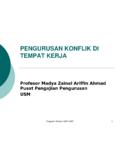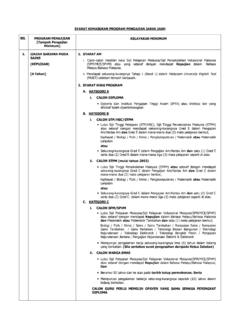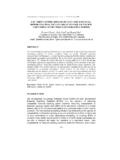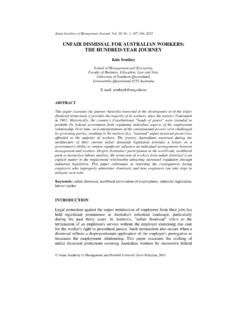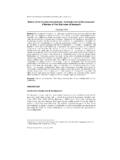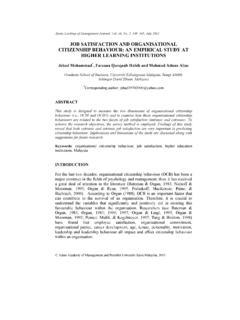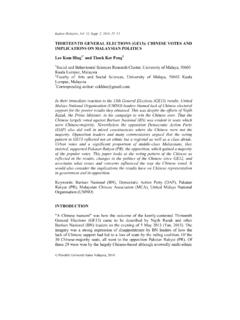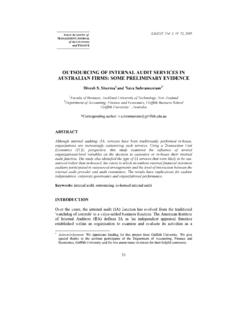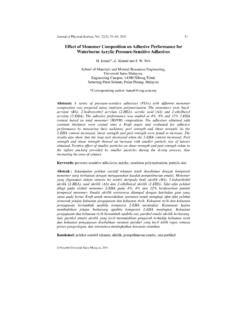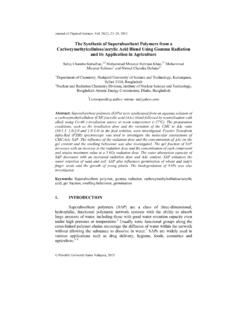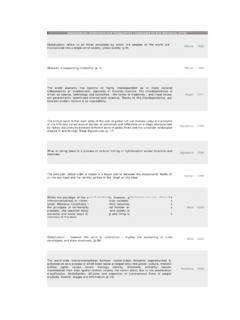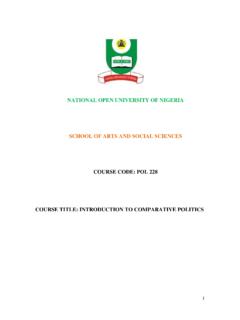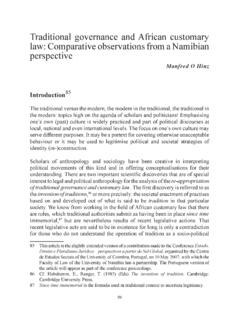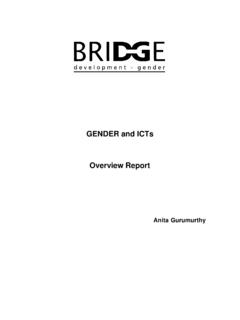Transcription of EXPLORING THE LINK BETWEEN LEARNING AND …
1 Asian Academy of Management Journal, Vol. 18, No. 2, 55 84, 2013 55 EXPLORING THE LINK BETWEEN LEARNING AND FIRM PERFORMANCE: AN EMPIRICAL STUDY OF PRIVATE MANUFACTURING FIRMS IN YANGON MYANMAR Nham Phong Tuan1* and Khine Tin Zar Lwin2 1 Faculty of Business Administration University of Economics and Business, Vietnam National University E4, 144 Xuan Thuy road, Cau Giay district, Hanoi, Vietnam 2 Faculty of Commerce Yangon Institute of Economics, Inya Road, Yangon, Myanmar *Corresponding author: ABSTRACT This paper focuses on evaluating the performance of firms from the knowledge and LEARNING perspective. The survey covered a random sample of 120 private manufacturing firms in industrial zones in the Yangon area. Two broad categories of LEARNING are determined: Internal and external.
2 Internal LEARNING is captured by two domains of LEARNING , individual and organisational, whereas external LEARNING involves customers, competitors and suppliers. Firm performance is evaluated using two broad groups of aspects: Non-financial and financial. The ordinary least square (OLS) results show that first, different domains of LEARNING affect firms performance differently. Individual, organisational and competitor LEARNING impact firms non-financial performance, whereas other forms of LEARNING do not. Second, the effect of different domains of LEARNING on performance differs in accordance with the different aspects of performance measurement. Individual LEARNING can explain firms' financial performance both directly and indirectly. However, organisational and competitor LEARNING explain firm financial performance indirectly.
3 Third, non-financial performance affects financial performance. Thus, the empirical results have important implications. Keywords: LEARNING , knowledge, performance, manufacturing firms INTRODUCTION Myanmar's economy has encountered significant changes after its transition to a market-oriented system. In the previous economic system, the participation of the private sector in economic activities is rather limited, and as a result, many private activities were confined to the small-scale industries that were operating in an unfavourable environment. However, after the transition to a market economic system, the government encouraged private sector participation in the national economy with the hope that promotion of the private sector would Nham Phong Tuan and Khine Tin Zar Lwin 56 strengthen the national economy and encourage economic development through competition in terms of the market mechanism.
4 Many former state-owned enterprises were privatised; industrial zones were established to promote their systematic development, and various laws were endorsed that allowed foreign-directed investment to facilitate the transfer of knowledge and technology to local firms. As a result, the number of private firms increased, along with their contribution to the GDP. However, the manufacturing sector's contribution to the GDP is still lower than that of the other sectors and that of the other least-developing countries in the region. The private manufacturing sector, which accounts for more than 75% of total manufacturing industries, has declined in recent years in terms of employment and value added (Industrial Development Committee, 2009). Despite globalisation and regional integration benefits in terms of access to better technology, many manufacturing firms find it difficult to survive because of the increased pressure stemming from higher-quality, cheaper imported products from neighbouring countries.
5 Although the total value of exported products has proved to be increasing, many firms have failed to access international markets. Their informal structure, resource scarcity and lack of managerial expertise may impede their ability to sustain competitive advantage in the long run. Rousseau (1997) suggested that to survive under rapid, intense competitive pressure, firms will need to learn at an increasingly rapid rate. LEARNING capability is regarded as a buffer for sustained organisational performance in single-unit firms, typically relatively smaller, entrepreneurial firms, and particularly, firms in our context. Hence, the successful LEARNING strategies of some firms could be expected to compensate for the firms' weaknesses in sustaining better performance.
6 However, a survey of the literature suggests that organisational LEARNING is one of the capabilities necessary for competitive advantage (Eisenhardt & Martin, 2000). Through LEARNING , firms may expand their ability and skill base and improve their ability to assimilate and utilise new information (Cohen & Levinthal, 1990; Leonard-Barton, 1992; Shilling, 2002). Organisational LEARNING has also been proposed as a viable strategy for firms attempting to survive when facing pressure (Rousseau, 1997). A number of researchers have shown that variations in firm performance can be observed because of differences in LEARNING capability (Nonaka & Takeuchi, 1995). However, these studies were conducted in the context of developed countries ( , Ruiz-Mercader, Meronon-Cerdan, & Sabater-Sanchez, 2006), which makes generalisation to Myanmar difficult.
7 In fact, firms in this sector in Myanmar are far from the research agenda to provide practitioners or policy makers with relevant policy interventions. In addition, these studies examined the sources of performance differences in terms of only internal or external variables. Actually, according to the absorptive capacity perspective, both are necessary for better performance because although internal variables such as individuals' knowledge and LEARNING and structural flexibility EXPLORING The Link BETWEEN LEARNING and Firm Performance 57 are important for the application and sharing of knowledge and LEARNING , competitive advantage is also dependent on openness to external changes. Therefore, drawing from essentials of empirical research in the Myanmar context and the demand for more comprehensive research, this study investigates how the different types of LEARNING contribute to firm performance.
8 To perform this investigation, this study identified the different types of LEARNING and how each type impacts firm performance. The study includes a set of specific objectives. First, the study investigates how different types of LEARNING impact firms' non-financial performance. Second, the relationship BETWEEN non-financial and financial performance is examined. Finally, the potential mediation effect of non-financial performance is explored. LITERATURE REVIEW AND HYPOTHESIS DEVELOPMENT Definitions of LEARNING Different definitions of LEARNING have been developed by various authors. For example, Fiol and Lyles (1985) indicated that LEARNING is the development of insights, knowledge and associations BETWEEN past actions, the effectiveness of those actions, and future actions.
9 Huber (1991) stated that an entity learns if, through the processing of information, the range of its potential behaviours is changed. Dimovski (1994) defined LEARNING as consisting of the following three processes: information acquisition, interpretation and behaviour and cognition changes. Crossan, Lane, White and Djurfeldt (1995) defined LEARNING as a process of change in cognition and behaviour and suggested that it does not necessarily follow that these changes will directly enhance performance. Despite variations, all these definitions fall under general classifications of LEARNING as lower order or higher order, double looped or single looped, generative or adaptive, adaptive or interpretative or combinations of two types. Although there is little agreement among theorists concerning the definition of LEARNING , they all appear to assume that LEARNING produces positive benefits to performance (Pamler & Cynthia, 2000).
10 Cognitive and Behavioural Perspectives on LEARNING Another issue to be addressed relates to the conceptualisation of LEARNING . Many previous researchers of organisational LEARNING focus on the conception of LEARNING in accordance with two contrasting theories with origins in the field of psychology: cognitive LEARNING theory and behaviour theory. Nham Phong Tuan and Khine Tin Zar Lwin 58 Studies using cognitive theory assumed LEARNING to be an interpretative perspective. According to this perspective, LEARNING is a cognitive development that does not induce any noticeable changes in behaviour (Crossan et al., 1995; Lundberg, 1995; Yeo, 2002). Researchers adopting the cognitive view focused on changes at various levels: changes in the state of knowledge or beliefs at an individual level, changes in shared understanding at the group level and changes to the storehouse of knowledge in the system, structure and procedures at the organisational level (Crossan et al.)
